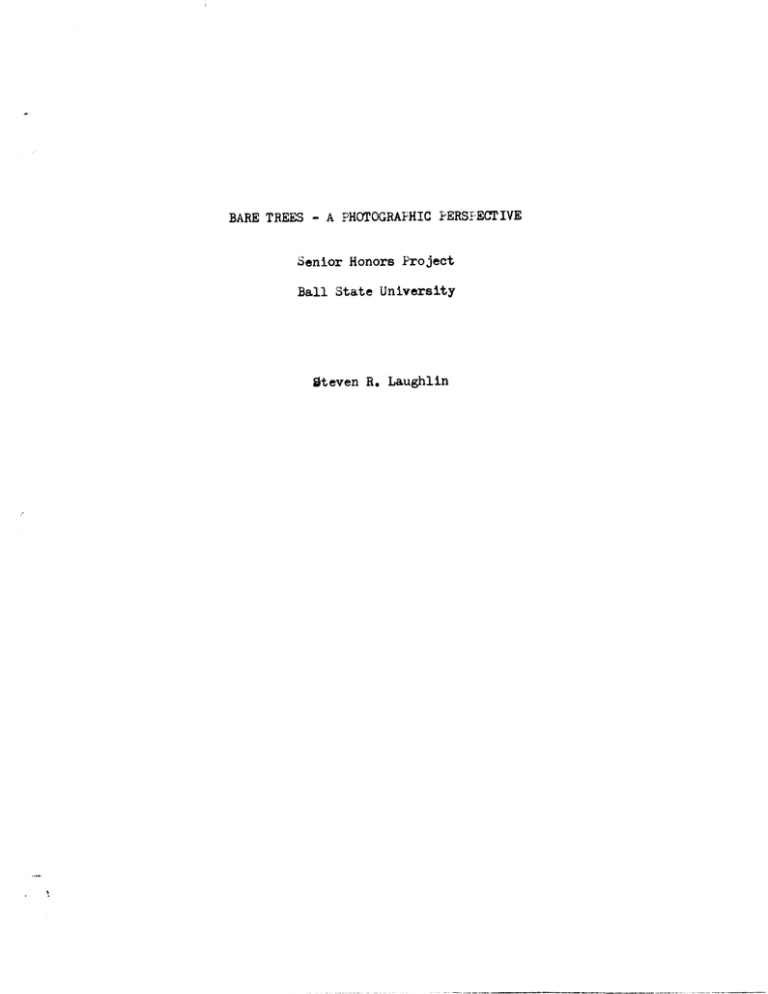BARE TREES - A PHCYrOGRAFHIC FERS:FECTIVE
advertisement

BARE TREES - A PHCYrOGRAFHIC FERS:FECTIVE Senior Honors Project Ball State University Steven R. Laughlin FOWARD My honors project consists of 22 black and white photographs of landscapes taken in and around the Pigeon River Fish and Wildlife Area. Of primary interest are trees, sans leaves. In this project I attempted to improve my technical ability as a photographer/developer and to expose the moods that bare trees bring to me. I would like to thank Dr. Warren VanderHill, Dr. CharI eel Mortensen, and Tom Yurkovic for their encouragement and inspiration. ---- --------------- -------- -- Abstracts of Reading Material "Wood. and -I'/ood. Grains", by Phil Brodatz, Dover Publications, New York, 1971. Brodatz's book consists of 112 black and white plates of wood grains, and structures constructed of wood such as fences, and cordwood. Also there were plates of stumDs, bark, and unusually shaped branches. There were also photomicrographs of wood. grain taken with the electron microscope. The techniques and prints were of standard types. "The Comrlete Book of Nature Photography", by Russ Kinne, Chilton Book Co., Philadelphia, 19,'1. Primarily concerned with wildlife. Instructive chapter on plant photography. Large emphasis on lenses and nighttime photography. Extremely good. on care of equipment in the out-of-doors. ".Photographing Na.ture", by G.J .H. Moon, Charles E. Tuttle Co., 1970. This book was primarily concerned with photographing birds. Basic subjects covered were the construction and placement of blinds, the use of artificial light, photographing birds in flight, and dealing with nighttime photography. There Waf; a short chapter on landscape photography with excellent information on the use of depths of field in obtaining desired effects. "The N-egative", by Ansel Adams, Morgan and Horgan Inc., Hastings on Hudson, New York, 1968. Adam$ describes the nature, composition, and effect of light upon photographic film a~d the resulting negative. It had little immediate bearing upon my work due to its level of technicality, but was informative nevertheless. "Photographing Na.ture", by the editors ofTime-Life Dooks, Time Inc., 1971. This is an ~!xcellent 'general' book, which covers all aspects of nature photography a beginner will encounter. with a large chapter concerning landscape photography, it served to be very useful. Of concern to the landscape photographer were composition, lenses, filters, themes, dealing with haze, bright sunlight, motion, and lighting in general. "Increasing Film Speed". by Mike Stensvold, Peterson Publishing Co., Los Angeles, California, 1978. This is an f!!xcellent small book concerned with 'pushing' film, that is rating film with a much higher ASA than the manufacturer's reccommended ASA. Differing films, developers and lab techniques are described. Bare Trees Even when very young I loved trees more than any other aspect of the out-of-doors. I lived for the first 18 years of my life upon a hill in central Indiana, surrounded as far as I could see by farmfields filled with corn, soybeans, pasture and livestock. The hill was a beautiful refuge from the monotony of monoculture, a haven in the true sense for people and wildllfe. There were several large maples, elm, mulberry and Scotch pine t.rees. J.here were also wild cherry, redbud, cottonwoods and shrubs of several kinds. In an environment of virtually flat farmland trees provided a topography of sorts, a vertical variation where little exsisted. Always my fa.scinations have tended toward the effect trees have upon their surroundings and upon the human beings that live with them. There is a subtlety, a softening of nature's harshness provided by trees that no other feature can provide. Bare trees are basically boring photographic subjects. Only the person with an aesthetic sense for the land will enjoy viewing my pictures. I also found it very difficult to compose pictures that didn't just look like snapshots of trees. After all, there's alot of them out there, and for every tree that is shaped unusually or is odd in some way, there are thousands that are not. Only about 10 percent of the photographs I took had enough 'something' about them to be printed. The rest bored even me, a confessed vegephiliac. Thi;s 10 percent could be the l'hotographer's Law, I'm not 2 sure, I haven't talked to that many other photographers about their ex periences. Through the photographs I have tried to TJresent the serenity and patience I feel is present in deciduous vegetation. Trees must know or believe that spring will come and life will accelerate to a full pace of physical growth. Only certain human beings doubt that warm weather will return. The rest of nature is based upon an accepting stoicism that is changeless and eternal. The longest Honors project in history is finally complete. (A mere two years incomplete.) class. It seems like 10 or 20 years since I signed up for the Honors projects are extremely exciting. They are the true challenge of the academic n~uveau,- do it by yourself or not at all. They also offer the all too rare option of chOOSing one's own subject of study, in my case black and white photography. The reasons I chose photography are fairly simp~e. I detest research which I define as the examination of the parts to determine the characteristics of the whole. I am much more comfortable with the process of creating a whole from an emotional pers",ective. Also, the technical process of taking a viewpoint and transferring i t to an image upon paper is extremely challenging, It being one of the most difficult processes I have encountered in my limited experience. Photography is very frustrating in this respect. To do all the processing involved from pressing a shutter release , to developing the ----_._--_._-_ ...__ ......... __.._- 3 negative and then developing a print is extremely difficult if one is trying to obtain flawless j~ages. This brings us to the main reason of this Honors project. I wished to improve my technical expertise, especially in taking and processing the best .- / negatives possible. (I firmly believe all of photography depends upon the quality of the negative.) To be frank, I was sorely disappointed in this respect. I basically destroyed more negatives than I perfected. From shooting single rolls of fUm twice, to using film too old, to not making note of what exposure index a roll of film was shot at, I made all the adolescent errors a photogra.pher can make. which is not to say I am disappointed with the project overall - in fact I'm pleased. With all the sef'backs and miscues I created I did manage to get enough good negatives to do rather well. /~~ ;y~~/(~~ ~_a~ -~----- ,..\.", I' j, ,. a;:' ,'.' .• c r 1 '~ 'I j. n ,,~b.r 1', <- ., pl"' f ... : c> • , . - "; ,,: J.,\, . • .f \ " ~ I i r • , ,, (, tr: ,l"," ! ,,' . 1 ~,,~ " \..JV t "It :.,: - .. , , , " 'i I I, ::(; 3 ,








